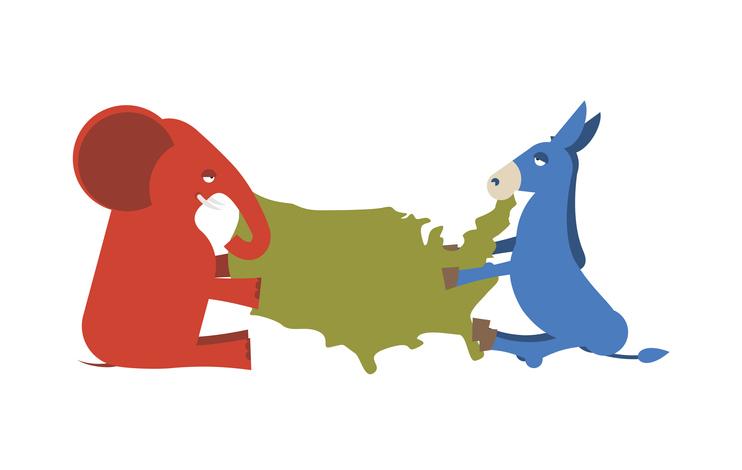
Nonpartisan Political Campaign Tips: Run a Political Campaign No Partisan Labels
Around the country, a lot of municipalities require that any mayoral and city council candidate run their political campaign in nonpartisan races. This means that candidates don’t run with an R or a D next to their names on the ballot. In many of these races, candidates will run at first in a primary and then a runoff or a general election, which take place if none of the candidates exceed a 50% threshold. In these races, voters who are paying close attention to the candidates will often be able to tell their likely party affiliation. While a lot of the techniques we talk about on this blog still apply to political campaigns for nonpartisan races, below is a list of a few elements specific to nonpartisan races that you should be thinking about when planning your campaign.
Your targeting can be broader
Predictably, in a nonpartisan race, the targeting for your communications program can be wider and broader than it would be in a partisan race. Since you won’t have a partisan label on the ballot, you can talk to more independent-minded voters and perhaps even voters who lean towards the other end of the political spectrum. These voters won’t have a preexisting notion about what you may or may not stand for, and you can have a more open conversation about your vision. Additionally, as we’ll discuss in more detail below, the issues you’ll be talking about in many of these nonpartisan races aren’t all that partisan after all (i.e., fixing potholes, addressing public safety concerns, etc.). Instead, they are often issues that voters care about regardless of political affiliation.
It’s all about the messaging
It’s already hard enough for political campaigns to develop a message that sinks in and resonates with voters. However, in nonpartisan races, a lot of a voters’ preexisting tropes about what you stand for won’t exist. Therefore, developing a clear message is absolutely essential to being successful in these types of political campaigns. Sure, name ID helps, but it’s usually not enough for a voter to have just heard your name before or seen it on a yard sign. In a nonpartisan political campaign, voters need to know why they should vote for you; otherwise, they’ll just skip voting in that race altogether.
You won’t have base voters to rely on
In partisan political campaigns, when you’re running in a simple general election, you generally will have a preexisting set of base voters who are likely to be on your side based on your party affiliation. But in a nonpartisan race, you can’t really count on this preexisting base of partisan support. Sure, there are going to be those people who Google you, determine that you’re the likely Democrat in the race, and support you because of that, but unfortunately, most voters will not put in the time to do that. While you would be likely to have these voters’ support if you had a D next to your name, in a nonpartisan race you’ll have to really work to communicate with them about who you are in order to get their support.
Drop off is a huge problem
We’ve written quite a bit about drop off/fall off voters. Most down ballot political campaigns already have a hard enough time fighting voter drop off. But in nonpartisan races where voters don’t have partisan labels, this problem is vastly compounded. If the voter doesn’t have an opinion about one of the candidates and don’t have partisan tropes to rely on in the absence of that knowledge, they’ll often just skip voting in that race altogether. For candidates running in nonpartisan races, you should be developing a plan from the get-go on how you’re going to combat voter drop off and communicate with people who are coming out to vote for President/Governor/US Senate but don’t have enough info to vote in your race.
Talk about the practical issues
One of the things we’ve seen work really well in nonpartisan races is speaking about practical, kitchen-table issues. Issues like fixing potholes, public safety, preventing flooding, etc. tend to make a huge impact in nonpartisan races. Think of these as the types of issues where voters tend to think, “everyone agrees that this needs to be fixed, why can’t the politicians find a way to get it done?” A lot of times we’re talking about these issues because they’re a big part of what municipal officials work on, but we also talk about them because they tend to bridge the political divide and can appeal to voters with a wide variety of political views. Since you can’t rely on a partisan base in these races, you really do need to try to cobble together a coalition of voters from across the political spectrum, and practical issues can help campaigns do that.
Endorsements can be really helpful
In the absence of partisan labels, endorsements in nonpartisan races can act as a proxy and give voters a clue of what you stand for. For instance, if you’ve been endorsed by the city’s Chamber of Commerce and a few elected Republican officials, that gives voters a major hint as to where you stand. If that were the case, you could send out a piece of mail to the most conservative voters highlighting these endorsements as a way to demonstrate your conservative bono fides. On the flip side, if you’ve secured endorsements from the city’s major labor unions and environmental groups, you may choose to send out a GOTV piece of mail to the most liberal voters touting those endorsements.
Have questions about running political campaigns in nonpartisan races? We’d love to talk to you about it! Reach out to The Campaign Workshop.